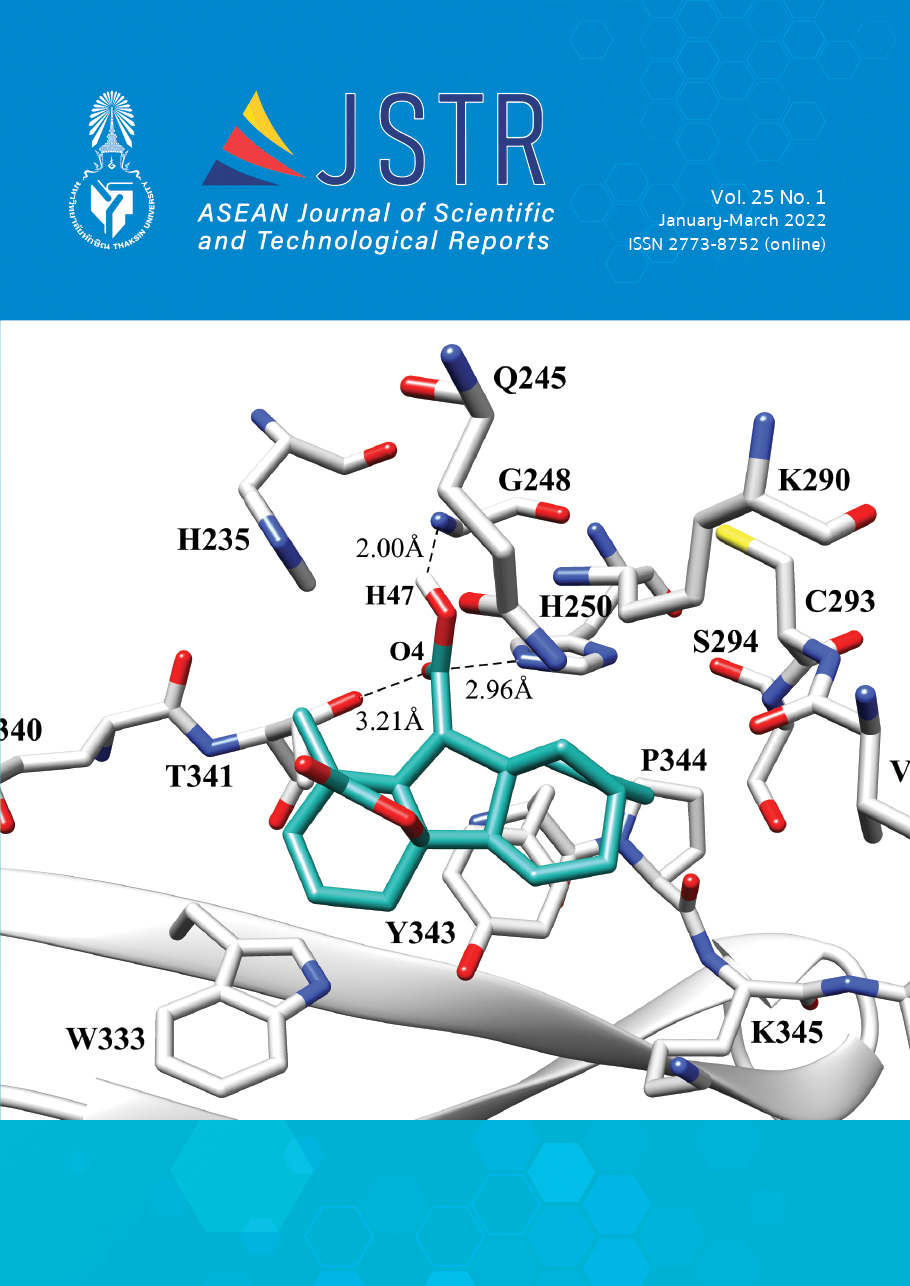The Differences of Precipitation Characteristics among GCMs over Southeast Asia under AR6 Climate Change Scenarios
Main Article Content
Abstract
Southeast Asia is known globally as a highly vulnerable climate change region. Precipitation is the primary factor that impacts livelihood in this region due to recurring flood and drought incidents. Variables projections under climate change can be made using General Circulation Models (GCMs). An investigation of projected precipitation with the new phase of the model experiment, the Sixth Assessment Report (AR6), is worth to be considered. This study investigates the spatial distributions of variability, trend and conditions (wet/dry) of precipitations generated using 10 GCMs over the SEA under AR6 with four scenarios (SSP1-2.6, SSP2-4.5, SSP3-7.0, and SSP5-8). Three statistical methods, coefficient of variation (CV), Mann-Kendall test (MK) and standardized anomaly index (SAI), were calculated by grid cells. Significant differences among GCMs could be seen in the results. High precipitation variation with CV was indicated around the southern part of Indonesia and the Philippines oceans for six models, whereas only one model (MRI-ESM2) returned strong variation for mainland countries. A decreasing precipitation trend during the historical period could be observed in mainland countries with four GCMs. However, the SSP3-7.0 and SSP5-8.5 of most models presented precipitation increment. The extremely wet and dry ratio to all other years was calculated. Highly wet years higher than 10% were indicated in SSP5-8.5 with MPI-ESM1 occurring in most areas of the region, whereas other models gave 6-10% of highly wet occurrence. Drought situation occurred higher than 10% and could be seen with only three models with small areas under all scenarios. returned strong variation for mainland countries. A decreasing precipitation trend during the historical period could be observed in mainland countries with four GCMs. However, the SSP3-7.0 and SSP5-8.5 of most models presented precipitation increment. The extremely wet and dry ratio to all other years was calculated. Highly wet years higher than 10% were indicated in SSP5-8.5 with
MPI-ESM1 occurring in most areas of the region, whereas other models gave 6-10% of highly wet occurrence. Drought situation occurred higher than 10% and could be seen with only three models with small areas under all scenarios.
Article Details

This work is licensed under a Creative Commons Attribution-NonCommercial-NoDerivatives 4.0 International License.
References
Asian Development Bank. The Economics of Climate Change in Southeast Asia: A Regional Review 2009; ISBN 978-971-561-787-1.
Hijioka, Y.; Lin, E.; Pereira, J.J.; Corlette, R.T.; Cui, X.; Insarov, G.E.; Lasco, R.D.; Lindgren, E.; Surjan, A. Asia. In: Climate Change: Impacts, Adaptation, and Vulnerability. Part B: Regional Aspects. Contribution of Working Group II to the Fifth Assessment Report of Intergovernment Panel on Climate Change 2014.
National Intelligence Council. Southeast Asia: The Impact of Climate Change to 2030: Geopolitical Implications. Conference Report CR 2010-02 January 2010.
Meinshausen, M.; Nicholls, Z.R.J.; Lewis, J.; Gidden, M.J.; Vogel, E.; Freund, M.; Beyerle, U.; Gessner, C.; Nauels, A.; Bauer, N.; Canadell, J.G.; Daniel, J.S.; John, A.; Krummel, P.B.; Luderer, G.; Meinshausen, N.; Montzka, S.A.; Rayner, P.J.; Reimann, S.; Smith, S.J.; Berg, M.; Velders, G.J.M.; Vollmer, M.K.; Wang, R.H.J. The shared socio-economic pathway (SSP) greenhouse gas concentration and their extensions to 2500. Geoscientific Model Development. 2020, 13, 3571-3605.
Fajardo, J.; Corcoran, D.; Roehrdanz, P.R.; Hannah, L.; Marquet P.A. GCM compareR: a web application to assess differences and assist in the selection of general circulation models for climate change research. Methods in Ecology and Evolution. 2020, 11, 656-663.
Raty, O.; Raisanen, J.; Ylhaisi, J. Evaluation of delta change and bias correction methods for future daily precipitation: intermodel cross-validation using Ensemble simulations. Climate Dynamics. 2014; 42, 2287-2303.
Charles J. V.; Douglas, E.M.; Green, P.A.; Revenga, C. Geospatial indicators of emerging water stress: an application to Africa. Ambio. 2005, 34(3), 230-236.
Bekele, F.; Mosisa, N.; Terefe, D. Analysis of current rainfall variability and trends over Bale-Zone, South Eastern Highland of Ethiopia. SF Journal of Global Warming. 2017, 1:2.
Pujiastuti, I.; Nurjani, E. Rainfall pattern variability as climate change impact in the Wallacea Region. IOP Conf. Series: Earth and Environmental Sciences. 2017, 148. 012023.
Eshetu, G.; Johansson, T.; Garedew, W. Rainfall trend and variability analysis in Setema-Gatira area of Jimma, Southwestern, Ethiopia. African Journal of Agricultural Research. 2016, 11(32), 3037-3045.
Archite, M.; Caloiero, T.; Walega, A.; Krakauer, N.; Hartanim T. Analysis of the spatiotemporal annual rainfall variability in the Wadi Cheliff Basin (Algeria) over the period 1970 to 2018. Water. 2021, 13, 1477.
John, A.S.; Brema, J. Rainfall trend analysis by Mann-Kendall test for Vamanapuram River basin, Kerala. International Jounral of Civil Engineering and Technology. 2018, 9(13), 1549-1556.
Hussain, F.; Nabi, G.; Boota, M.W. Rainfall trend analysis by using the Mann-Kendall test & Sen’s slope estimates: a case study of district Chakwak rain gauge, Barani area, Northern Punjab province, Pakistan. Science International (Lahore). 2015, 27(4), 3159-3165.
Gadedjisso-Tossou, A.; Adjegan, K.L.; Kablan, A.K.M. Rainfall and temperature trend analysis by Mann-Kendall test and significance for rainfed cereal yields in Northern Togo. Sci. 2021, 3(17). 1-20.
Ahmad, I.; Tang, D.; Wang, T.; Wang, M.; Wagan, B. Precipitation trends over time using Mann-Kendall and Spearman’s rho tests in Swat River basin, Pakistan. Advances in Meteorology. 2015, 431860.
Koudahe, K.; Kayode, A.J.; Samson, A.O.; Adebola, A.A.; Djaman, K. Trend analysis in standardized precipitation index and standardized anomaly index in the context of climate change in Southern Togo. Atmospheric and Climate Sciences. 2017, 7, 401-423.
Bayable, G.; Amare, G.; Alemu, G.; Gashaw, T. Spatiotemporal variability and trends of rainfall and its association with Pacific Ocean Sea surface temperature in West Harerge zone, Eastern Ethiopia. Environmental Systems Research. 2021, 10(7). 1-21.
Supharatid, S.; Nafung, J.; Aribarg, T. Projected changes in temperature and precipitation over mainland Southeast Asia by CMIP6 models. Journal of Water and Climate Change. 2021, doi.10.2166/wcc.2021.015.
Ge, F.; Zhu, S.; Luo, H.; Zhi, X.; Wang, H. Future changes in precipitation extremes over Southeast Asia: insights from CMIP6 multi-model ensemble. Environmental Research. 2021, 16, 024013.
Lqbal, Z.; Shahid, S.; Ahmed, K.; Wang, X. Evaluation of CIMP6 GCM rainfall in mainland Souteast Asia. Atmospheric Research. 2021, doi.10.1016/j.atmosres.2021.105525.


